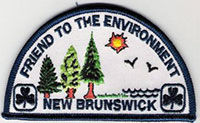Friend to the Environment Challenge Day
Earth Day is April 22; but we should Take Action any day of the year. This is a great opportunity to get girls together and do the Friend to the Environment Challenge. This would also be a great bridging activity by having the Pathfinders and Rangers help organize and do the day. The crest is available at the Guide Office.
A great resource for environment issues is the Canadian Wildlife Federation. Enter into their “search” what you are looking for (ex. duck nesting boxes) and there it is.
- Make a musical instrument and sing some songs about recycling or make up your song about recycling and the environment.
Provide lots of materials. Plastic containers, elastics, string, boxes (cereal, pudding, etc) plastic spoons, pop or juice bottles, sticks. Beans, rice or small pebbles for noise. Don’t forget the tape and glue and decorations.
- Make a cloth bag. Sew one and add your own environment message with paint or markers or an iron transfer. Or make a simple one from an old t-shirt. Just cut off the sleeves and trim around the neck. It will look sort of like a tank top or better yet start with a tank top. (no cutting). Thread a string or yarn through the seam at the bottom and
draw up tight or cut off the bottom edge and then make small slits all along the bottom and weave the cut off part through and draw up tight and tie. You could also just sew along the bottom (this would be sewing magic for Embers).
Sew up simple cloth bags, add a message, add a note saying who made it; just your unit name or just GGC and give them to shoppers at the grocery store on their way in to shop.
Water
- Where does water come from? Hint: “Explore water with Holly Heron” is a great resource!
- How much water do we use in a day? Can we use less?
- Check out a pond or stream to see what lives there. Cut the bottom from a plastic container or large can cover with plastic wrap held on with an elastic and then push it down into the water and you can look under the water.
Animals
- Where are they? Who are they?
- What is “endangered”? Are there any in Canada? Check out the Canadian Wildlife Federation web site.
- What is habitat? On a hike try to find some animal homes. Don’t disturb them. Make a home for an animal. Can be a small little shelter of twigs or a toad abode for your garden. Place a terra cotta flower pot, even a broken one, on its side in a shady part of the garden, with some moss or dried leaves and a bit of soil. Decorate it with markers or stones glued to the top half.
Or maybe a home for Lady Bugs — roll some corrugated cardboard to fit inside a bottle. Use a water/pop bottle that has had the top neck part cut off. Put it in the slightly tilted to keep the rain out.
- Make bat house which can be just some roofing (tar) paper wrapped around a tree tight at the top and flared at the bottom. Directions for bat houses and duck boxes can be found.
- Play a stalking or camouflage game. Take Cover or hide and seek.
- Make Bug suckers and catch some bugs investigate and then release.
Footprint
- Invite a resource person from the Waste Management plant. They can explain what can be recycled and why; how we can use less; and why we need to be doing this.
Natural Resources
- Have a member of Natural resources or the Angling Association attend to discuss careers in the environment, what is being done to conserve our natural resources.
Spread The Green Word
- Make posters to put up in your community about the need to be green.
- Design t-shirt logos.
- Write an article for the local newspaper or school newsletter.
- Organize a litter pick up.
Bug Sucker
You’ll need a clear plastic container at least 6cm high with a “lock” type or snap on lid; two flexible drinking straws (not too small); small piece of nylon stocking (4cmX8cm); small elastic (no tangle ones work great); white glue, hammer & nail.
- Punch two holes 1 cm. apart in the lid of the container. Each hole should be the diameter of the straw.
- Put the short end of one straw in one hole, angle makes it easier) Pull it through the lid.
- Double the piece of nylon and attach to end elastic.
- Pull the short end of the other straw through the lid. Pull it through to about 3cm.
(cut straw on about 3cm.
of straw with
the other hole in.
- The straws should fit tightly into lid, if not seal gaps with white glue.
- Put the lid on the container. Point the long straw (one without the nylon) at a bug and suck it up with the other straw. Observe it and then release it.
The bendy parts of the straws are on the outside. You want a long piece of straw reaching out to the bug. The straws have to be big enough to catch a fair size bug without it getting stuck in the straw. If you are using a pill bottle be sure it has been washed. HAVE FUN!